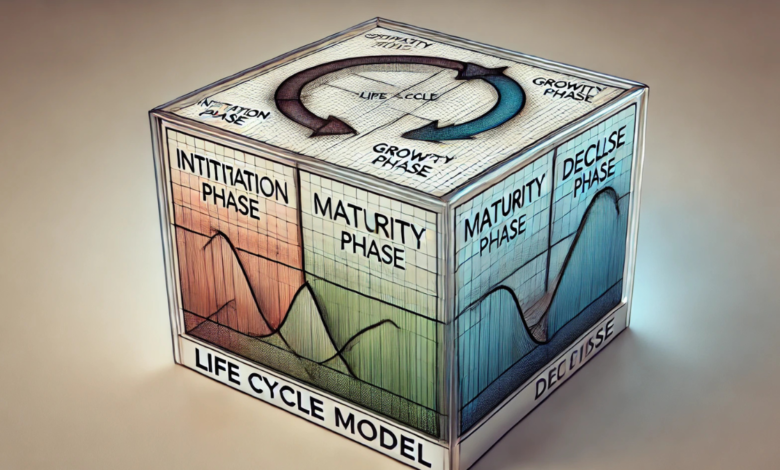Life Cycle Model Four Sided Box: A Comprehensive Guide

Introduction to Life Cycle Model Four Sided Box
1.1 What Is the Four-Sided Box Life Cycle Model?
Life Cycle Model Four Sided Box is a strategic framework designed to guide organizations, projects, or initiatives through their various stages of development. It divides Life Cycle Model Four Sided Box phases: Initiation, Development, Maturity, and Renewal or Decline. This model provides a structured approach to decision-making, ensuring that all critical aspects of growth and sustainability are addressed systematically.
The term “Life Cycle Model Four Sided Box” symbolizes a holistic structure, where each side represents a phase integral to the overall process. This framework emphasizes balance and adaptability, recognizing that success depends on thoroughly understanding each phase’s unique challenges and opportunities.
1.2 Importance of Life Cycle Model Four Sided Box in Strategic Planning
Life cycle models like the Life Cycle Model Four Sided Box serve as roadmaps, helping organizations anticipate challenges and allocate resources effectively. Unlike ad-hoc approaches, these models provide clarity and direction, enabling leaders to make informed decisions.
Life Cycle Model Four Sided Box stands out due to its versatility. Whether applied to business strategies, product development, or organizational growth, it ensures that every phase of the cycle is accounted for, reducing risks and maximizing potential. Organizations can proactively address issues and capitalize on opportunities by understanding where they are within the cycle.
1.3 Overview of the Four Sides of the Model
Life Cycle Model Four Sided Box—Initiation, Development, Maturity, and Renewal or Decline—are interconnected, creating a continuous loop. Each side represents a stage with distinct goals and challenges. This cyclical nature ensures that the end of one phase naturally transitions into the next, fostering continuous improvement and resilience.
The Four Sides of the Model: A Deep Dive
2.1 Side One: Initiation
The initiation phase marks the beginning of the life cycle model four sided box, where ideas are conceptualized and foundational plans are laid. It involves identifying goals, assessing feasibility, and engaging stakeholders. This phase is critical, as it sets the stage for everything that follows.
Key activities in this phase include market research, defining objectives, and creating a clear roadmap. Collaboration among life cycle model four sided box ensures alignment, while risk assessment identifies potential challenges. Success in the initiation phase often depends on robust planning and clear communication.
2.2 Side Two: Development
The development phase transforms ideas into actionable strategies. This is where resources are mobilized, processes are established, and initial results take shape. It’s a dynamic stage characterized by growth and adaptation.
During this phase, organizations life cycle model four sided box on execution. Resource allocation, project management, and performance monitoring are critical. Budget constraints or unforeseen obstacles often arise, requiring flexibility and problem-solving skills. Milestones and key performance indicators (life cycle model four sided box) help track progress and ensure alignment with objectives.
2.3 Side Three: Maturity
Maturity represents the peak of stability and efficiency. By this stage, the organization or initiative has established itself, achieving consistent results and market positioning. However, this phase also brings challenges, such as the risk of stagnation.
Organizations in the maturity phase must focus on sustaining growth. This involves optimizing processes, maintaining customer satisfaction, and staying competitive. Regular evaluations ensure that the organization remains relevant and agile, preventing complacency.
2.4 Side Four: Renewal or Decline
The final side of the model highlights a critical juncture: renewal or decline. Organizations must decide whether to innovate and rejuvenate life cycle model four sided box accept a natural decline. Renewal involves identifying opportunities for reinvention, while decline necessitates planning for an orderly exit.
Key strategies for renewal include leveraging emerging technologies, exploring new markets, and fostering a culture of innovation. Decline, however, requires maximizing remaining value and transitioning gracefully.
Applications and Practical Implementation

3.1 How Businesses Utilize the Model
Businesses across industries utilize life cycle model four sided box to navigate complex challenges and seize opportunities. For example, startups use it to scale operations effectively, while established companies rely on it to sustain market leadership.
Case studies demonstrate its versatility. A technology firm might use the model to guide product development, while a nonprofit could apply it to enhance program effectiveness. Customizing the model to align with specific goals ensures its relevance and impact.
3.2 Leveraging Technology to Enhance the Life Cycle
Technology plays a pivotal role in optimizing the Four-Sided Box model. AI and data analytics provide valuable insights, enabling organizations to monitor progress and make data-driven decisions. Digital platforms facilitate collaboration and streamline processes, enhancing efficiency.
For instance, predictive analytics can identify trends, helping organizations anticipate changes and adapt proactively. This reduces risks and ensures sustained success across all life cycle phases.
3.3 Challenges in Applying the Four-Sided Box Model
Implementing life cycle model four sided box is not without challenges. Common pitfalls include resistance to change, inadequate resources, and stakeholder misalignment. Overcoming these obstacles requires strong leadership, effective communication, and a commitment to continuous improvement.
Balancing structure with flexibility is crucial. While the model provides a framework, adapting it to the organization’s unique context and needs is essential.
The Impact of the Four-Sided Box Model on Long-Term Success
4.1 Benefits of Using the Model
life cycle model four sided box numerous benefits, including improved strategic clarity, enhanced adaptability, and sustainable growth. Organizations can navigate uncertainties and capitalize on opportunities by addressing each phase comprehensively.
Additionally, the model fosters a proactive approach, enabling organizations to anticipate challenges and respond effectively. This reduces risks and enhances resilience, ensuring long-term success.
4.2 Insights from Real-Life Implementations
Real-world examples illustrate the life cycle model four sided box effectiveness. Companies that have successfully applied it highlight the importance of adaptability, collaboration, and continuous learning. These lessons provide valuable insights for organizations seeking to achieve similar results.
Conclusion
life cycle model four sided box offers a comprehensive framework for navigating growth and sustainability. Its structured approach ensures that organizations can address challenges, seize opportunities, and achieve long-term success. Businesses and individuals can thrive in an ever-changing landscape by understanding and leveraging the model’s four sides.
Frequently Asked Questions (FAQs)
Q: What makes the Four-Sided Box Life Cycle Model unique compared to other models?
A: Its holistic approach and cyclical nature ensure comprehensive coverage of all growth phases, making it adaptable to diverse contexts.
Q: Can this model be applied to non-business contexts?
A: Yes, the model’s versatility makes it applicable to personal development, social projects, and other non-business scenarios.
Q: How can an organization determine if it is in the maturity phase?
A: Key indicators include consistent performance, stable market position, and optimized processes.
Q: What are the early warning signs of the decline phase?
A: Signs include declining market share, reduced innovation, and customer dissatisfaction.
Q: Are there specific tools or frameworks that complement the Four-Sided Box Model?
A: Tools like SWOT analysis, KPIs, and digital collaboration platforms enhance its effectiveness.
You May Also Read: https://topblogbuz.com/christian-fundraising-sites/





